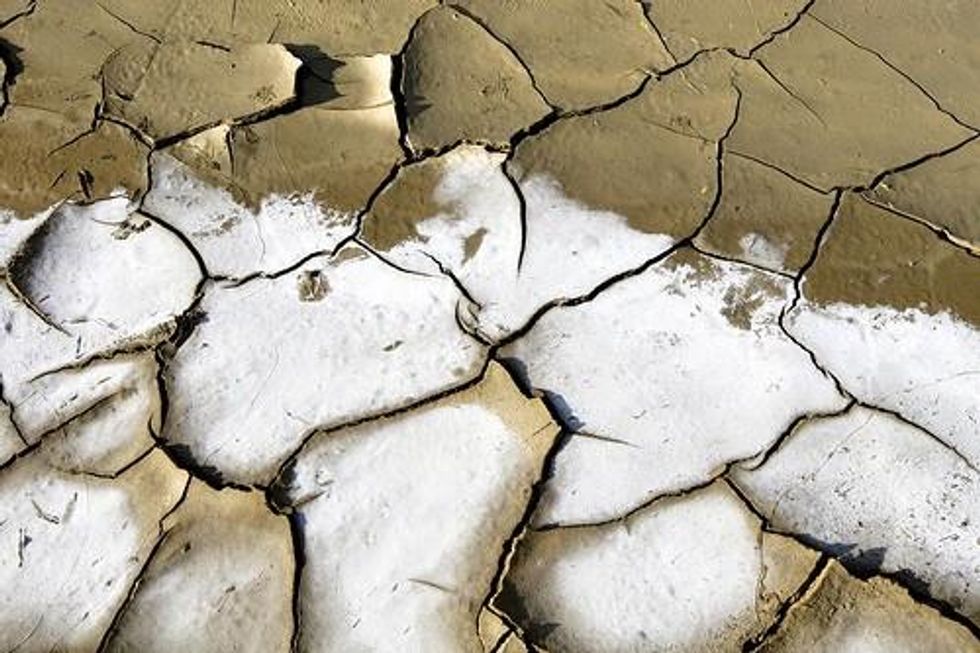As Planet Warms, 13% of Humanity Headed for Worse Water Scarcity
New studies finds 1 billion will face new or increased water scarcity by the century's end if 'business continues as usual'

"If population growth continues, by the end of our century under a business-as-usual scenario these figures would equate to well over one billion lives touched," Gerten points out. "And this is on top of the more than one billion people already living in water-scarce regions today."
Researchers warn that the planet is headed for severe scarcity in which the global poor, as well as people living in parts of Asia and North Africa, the Mediterranean, and the Middle East, will be hardest hit. "Now this is not a question of ducks and daisies, but of our unique natural heritage, the very basis of life," said Hans Joachim Schellnhuber, one of the co-authors and director of PIK, in a Tuesday announcement about the the studies.
The current pledges of the international community to reduce greenhouse gas emissions are not aggressive enough to curb the spiraling problem of water scarcity, researchers found in a series of modeling studies.
"Mean global warming of 2 degrees, the target set by the international community, is projected to expose an additional 8 percent of humankind to new or increased water scarcity," says Dieter Gerten, lead-author of one of the studies. "3.5 degrees - likely to occur if national emissions reductions remain at currently pledged levels - would affect 11 percent of the world population."
If the globe warms 5 degrees Celsius, which PIK says it is on-target to do by the end of the century if "business-as-usual" continues, the number of people directly affected by new or increased water scarcity will reach well over 1 billion, a stunning 13 percent of the global human population.
"Our findings support the assertion that we are fundamentally destabilizing our natural systems," says Wolfgang Lucht, one of the authors and co-chair of PIK's Research Domain of Earth System Analysis. "[W]e are leaving the world as we know it."
_____________________
An Urgent Message From Our Co-Founder
Dear Common Dreams reader, The U.S. is on a fast track to authoritarianism like nothing I've ever seen. Meanwhile, corporate news outlets are utterly capitulating to Trump, twisting their coverage to avoid drawing his ire while lining up to stuff cash in his pockets. That's why I believe that Common Dreams is doing the best and most consequential reporting that we've ever done. Our small but mighty team is a progressive reporting powerhouse, covering the news every day that the corporate media never will. Our mission has always been simple: To inform. To inspire. And to ignite change for the common good. Now here's the key piece that I want all our readers to understand: None of this would be possible without your financial support. That's not just some fundraising cliche. It's the absolute and literal truth. We don't accept corporate advertising and never will. We don't have a paywall because we don't think people should be blocked from critical news based on their ability to pay. Everything we do is funded by the donations of readers like you. Will you donate now to help power the nonprofit, independent reporting of Common Dreams? Thank you for being a vital member of our community. Together, we can keep independent journalism alive when it’s needed most. - Craig Brown, Co-founder |

"If population growth continues, by the end of our century under a business-as-usual scenario these figures would equate to well over one billion lives touched," Gerten points out. "And this is on top of the more than one billion people already living in water-scarce regions today."
Researchers warn that the planet is headed for severe scarcity in which the global poor, as well as people living in parts of Asia and North Africa, the Mediterranean, and the Middle East, will be hardest hit. "Now this is not a question of ducks and daisies, but of our unique natural heritage, the very basis of life," said Hans Joachim Schellnhuber, one of the co-authors and director of PIK, in a Tuesday announcement about the the studies.
The current pledges of the international community to reduce greenhouse gas emissions are not aggressive enough to curb the spiraling problem of water scarcity, researchers found in a series of modeling studies.
"Mean global warming of 2 degrees, the target set by the international community, is projected to expose an additional 8 percent of humankind to new or increased water scarcity," says Dieter Gerten, lead-author of one of the studies. "3.5 degrees - likely to occur if national emissions reductions remain at currently pledged levels - would affect 11 percent of the world population."
If the globe warms 5 degrees Celsius, which PIK says it is on-target to do by the end of the century if "business-as-usual" continues, the number of people directly affected by new or increased water scarcity will reach well over 1 billion, a stunning 13 percent of the global human population.
"Our findings support the assertion that we are fundamentally destabilizing our natural systems," says Wolfgang Lucht, one of the authors and co-chair of PIK's Research Domain of Earth System Analysis. "[W]e are leaving the world as we know it."
_____________________

"If population growth continues, by the end of our century under a business-as-usual scenario these figures would equate to well over one billion lives touched," Gerten points out. "And this is on top of the more than one billion people already living in water-scarce regions today."
Researchers warn that the planet is headed for severe scarcity in which the global poor, as well as people living in parts of Asia and North Africa, the Mediterranean, and the Middle East, will be hardest hit. "Now this is not a question of ducks and daisies, but of our unique natural heritage, the very basis of life," said Hans Joachim Schellnhuber, one of the co-authors and director of PIK, in a Tuesday announcement about the the studies.
The current pledges of the international community to reduce greenhouse gas emissions are not aggressive enough to curb the spiraling problem of water scarcity, researchers found in a series of modeling studies.
"Mean global warming of 2 degrees, the target set by the international community, is projected to expose an additional 8 percent of humankind to new or increased water scarcity," says Dieter Gerten, lead-author of one of the studies. "3.5 degrees - likely to occur if national emissions reductions remain at currently pledged levels - would affect 11 percent of the world population."
If the globe warms 5 degrees Celsius, which PIK says it is on-target to do by the end of the century if "business-as-usual" continues, the number of people directly affected by new or increased water scarcity will reach well over 1 billion, a stunning 13 percent of the global human population.
"Our findings support the assertion that we are fundamentally destabilizing our natural systems," says Wolfgang Lucht, one of the authors and co-chair of PIK's Research Domain of Earth System Analysis. "[W]e are leaving the world as we know it."
_____________________

